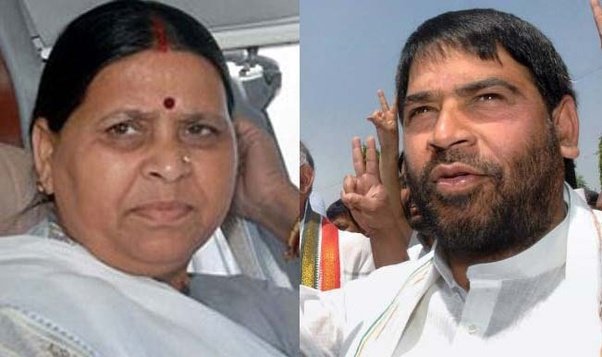The Shilpi Jain and Gautam Singh case remains one of Bihar’s darkest unsolved mysteries. On July 3, 1999, the bodies of 23-year-old Shilpi Jain, a former Miss Patna, and her boyfriend, 27-year-old Gautam Singh, were found in a Maruti Zen car in a garage near MLA Quarter No. 12, Fraser Road, Patna. Officially declared a double suicide by the CBI, the case has been shrouded in allegations of murder, rape, and political cover-up, fueling the narrative of “Jungleraj” under the RJD government. Know the name of the individuals suspected of involvement and top-secret details that continue to haunt this tragedy.
The Crime That Shocked Patna
On July 3, 1999, Patna woke to chilling news: Shilpi Jain and Gautam Singh were found dead in a car parked in a garage linked to RJD MLA Sadhu Yadav, brother-in-law of then-CM Rabri Devi. Shilpi, a vibrant student, and Gautam, an RJD youth leader, were in a relationship. The police claimed suicide, but the semi-nude state of the bodies and signs of violence sparked murder allegations. The case, tied to powerful political figures, became a symbol of Bihar’s lawlessness, with public outcry demanding truth. Suspicions of rape and a botched investigation kept the case alive, despite its closure in 2003.
The Scene of the Crime
The bodies were discovered in a Maruti Zen inside a garage at MLA Quarter No. 12, Fraser Road, owned by Sadhu Yadav. Shilpi was semi-nude, wearing Gautam’s shirt, while Gautam was fully unclothed. Reports noted signs of struggle, and the car was driven to the police station by a constable before proper forensic analysis, compromising evidence. Supporters of an unnamed MLA allegedly reached the scene first, tampering with the bodies and car, raising questions about deliberate sabotage. These early mishandlings fueled distrust in the investigation.
Initial Public Reaction
Patna erupted in protests, with candlelight vigils at Gandhi Maidan demanding justice. Shilpi’s family, led by her father, Ujjwal Jain, rejected the suicide narrative, alleging murder and rape. Media outlets, including Dainik Bhaskar, reported claims of sexual assault by multiple perpetrators, amplifying public anger. The case’s political links to the RJD government, then led by Rabri Devi, led to accusations of “Jungleraj,” where crime thrived under political protection. The outrage forced the case’s transfer to the CBI in September 1999.
Individuals Suspected in the Case
While no one was formally charged with murder, several individuals were suspected due to their alleged connections to the crime. Sadhu Yadav, an RJD MLA, was the primary figure named, given the crime scene’s link to his property. Others, including unnamed RJD leaders and associates, were implicated in rumors of a cover-up. Shilpi’s family and media reports pointed to a high-profile youth leader who refused DNA testing, but his identity was never officially disclosed. These suspicions, though unproven, kept the case in the spotlight.
Sadhu Yadav’s Alleged Role
Sadhu Yadav, brother-in-law of Lalu Prasad Yadav, was the most prominently suspected figure. The crime occurred at his MLA quarter, and Gautam Singh was his business partner in the Silver Oak restaurant. Reports alleged Sadhu’s involvement in the assault and murder, with claims he pressured police to close the case. In 2021, Tej Pratap Yadav, Lalu’s son, publicly accused Sadhu of involvement, though Sadhu denied it. His refusal to provide semen samples for CBI testing deepened suspicions, but no charges were filed.
The Unnamed MLA and Associates
Sources, including a 2022 Daijiworld report, suggested an unnamed RJD MLA was involved, with Shilpi allegedly assaulted at a circuit house in Phulwari Sharif before her death. Gautam, who reportedly introduced Shilpi to this MLA, may have intervened, leading to both their deaths. The MLA’s supporters allegedly tampered with evidence at the scene. A “high-profile youth leader” mentioned in DNA test refusals was never named, but speculation pointed to RJD insiders. These figures remain shadowy, protected by political clout.
Gautam Singh’s Involvement
Gautam Singh, the co-victim, was also scrutinized. As an RJD youth leader and Sadhu Yadav’s associate, he reportedly linked Shilpi to the MLA involved. Some theories suggest Gautam’s attempt to intervene at the circuit house led to his death alongside Shilpi’s. While not a suspect in the traditional sense, his political ties and role in Shilpi’s final hours raised questions about his intentions and whether he unknowingly led her into danger. His death, however, silenced any answers he might have provided.
Top Secret Revelations from Sources
The Shilpi Jain case is rife with top-secret details that never fully surfaced, buried under political pressure and investigative lapses. DNA evidence confirmed Shilpi was gang-raped by multiple perpetrators, but the identities of those involved were concealed. The mishandling of evidence, including the car and fingerprints, pointed to deliberate sabotage. Allegations of a circuit house assault and political interference by RJD leaders painted a grim picture of Jungleraj, where power trumped justice. These secrets, though unproven, continue to fuel demands for truth.
DNA Evidence of Gang Rape
A DNA test on Shilpi’s vaginal fluid, sent to Hyderabad, confirmed she was raped by more than one person before her death. This explosive finding, reported by sources like Brainly.in, was dismissed by the CBI, which claimed stains on her clothes were sweat, not semen. The refusal of a high-profile RJD youth leader to provide blood or semen samples halted further identification. Shilpi’s family and supporters believe this evidence was suppressed to protect powerful culprits, a secret that remains locked away.
The Circuit House Assault Theory
Sources, including Daijiworld and Satyaagrah, reported that on July 2, 1999, Shilpi was intercepted by a known person while heading to her computer class. She was taken to a circuit house in Phulwari Sharif, where she was allegedly sexually assaulted by an RJD MLA and others. Gautam, suspecting foul play, followed her there, leading to their murders to silence them. This theory, ignored by police due to alleged RJD pressure, suggests a premeditated crime hidden by political influence.
Evidence Tampering and Investigation Flaws
The investigation was riddled with errors. The car was driven from the crime scene without forensic analysis, and no fingerprints were recovered from the steering wheel. Supporters of the MLA arrived before police, tampering with the bodies and car, as noted in Social News XYZ. The CBI’s 2003 report, closing the case as suicide without a viscera report, ignored initial police findings of murder and rape. These lapses, widely believed to be deliberate, protected suspects and buried the truth.
The Investigation’s Failures
The Patna police and CBI faced heavy criticism for their handling of the case. The police’s rush to declare suicide, despite signs of violence, and their failure to secure the crime scene sparked outrage. The CBI, tasked with a fair probe in September 1999, took four years to conclude suicide, ignoring DNA evidence and family claims. Allegations of political pressure from the RJD government, led by Rabri Devi, suggested a cover-up to shield Sadhu Yadav and others. The investigation’s closure left Shilpi’s family without justice.
Police Mishandling
Patna police botched the initial investigation. They drove the car to the station, compromising evidence, and failed to collect fingerprints properly. Supporters of an MLA tampered with the scene before police arrived, as reported by Daijiworld. The suicide verdict came before the postmortem, ignoring signs of struggle and assault. Opposition parties accused SP City Bhatia of shielding Sadhu Yadav under Rabri Devi’s orders. These failures, seen as deliberate, fueled public distrust and forced the case’s transfer to the CBI.
CBI’s Controversial Closure
The CBI’s 2003 report, declaring the deaths a suicide, stunned Shilpi’s family. Despite early indications of murder and rape, the agency found no evidence of foul play, dismissing DNA findings as inconclusive. Ujjwal Jain, Shilpi’s father, called the CBI’s credibility “doubtful,” noting their initial admission of murder. The four-year delay and refusal of key suspects to provide DNA samples suggested external pressure. The closure, seen as a whitewash, cemented the case as a symbol of Jungleraj’s failures.
The Family’s Ongoing Struggle
Shilpi’s family, led by Ujjwal and Neera Jain, fought relentlessly for justice. They rejected the CBI’s suicide verdict, alleging murder and rape by powerful figures. Their son, Prashant Jain, was kidnapped in 2006 while trying to reopen the case, a chilling warning to back off. Despite threats, the family’s public statements kept the case alive, though no new probe was launched. Their pain, shared in media like Times of India, reflects the struggle of ordinary families against Bihar’s political machine.
Prashant Jain’s Kidnapping
In 2006, Prashant Jain was abducted from Buddha Marg, Patna, near his home. The incident, reported by Times of India, occurred as he pushed to reopen Shilpi’s case. Kidnapped in a Maruti Esteem by unidentified men, he was later freed, but the message was clear: stop digging. The proximity to Kotwali police station highlighted law enforcement’s failure to protect. This act of intimidation silenced further efforts, leaving the family fearful but resolute in their belief that Shilpi was murdered.
Public Support and Protests
Shilpi’s family wasn’t alone. Patna’s residents, especially students and women’s groups, rallied behind them. Candlelight vigils and protests at Gandhi Maidan demanded a fair investigation. Media outlets, including Open The Magazine, amplified their cause, with journalists like Chinki Sinha, Shilpi’s junior, writing passionately about the injustice. The family’s fight inspired broader calls for reform, but the lack of progress left many disillusioned, seeing the case as proof that power trumped justice in 1990s Bihar.
The Legacy of the Case
The Shilpi Jain case remains a wound in Bihar’s history, a stark reminder of Jungleraj’s dark days. It exposed the nexus of crime and politics, where figures like Sadhu Yadav allegedly operated with impunity. The case’s revival in media, like the 2022 series Maharani 2, and Tej Pratap Yadav’s 2021 accusations against Sadhu, keep it alive. It spurred demands for women’s safety and transparent policing, though justice for Shilpi remains elusive. Her story is a call to reform a system that failed her.
Impact on Bihar’s Politics
The case rocked Bihar’s political landscape. Opposition parties, like the BJP, used it to attack the RJD’s governance, labeling it Jungleraj. The scandal contributed to the RJD’s 2005 election loss to Nitish Kumar’s coalition. Sadhu Yadav’s alleged role became a rallying cry for reform, though he faced no charges. The case’s political fallout, as seen in Maharani 2’s portrayal, continues to shape debates about law and order in Bihar, highlighting the cost of unchecked power.
Calls for Justice Today
Even in 2025, Shilpi’s case resonates. Her family’s unanswered pleas and Prashant’s kidnapping underscore the need for accountability. Activists and journalists, inspired by accounts like Chinki Sinha’s, urge a fresh investigation using modern forensics. The case’s mention during Tejashwi Yadav’s 2021 wedding shows its enduring relevance. As Bihar strives for progress, reopening Shilpi’s case could restore trust, proving justice isn’t just for the powerful. Until then, Shilpi remains a symbol of a fight unfinished.



